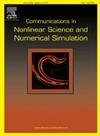Bifurcation dynamics of a predator–prey model with impulsive density-dependent nonlinear pesticide spraying and predator release
IF 3.8
2区 数学
Q1 MATHEMATICS, APPLIED
Communications in Nonlinear Science and Numerical Simulation
Pub Date : 2025-06-04
DOI:10.1016/j.cnsns.2025.108979
引用次数: 0
Abstract
In this study, we propose a predator–prey model incorporating impulsive density-dependent nonlinear pesticide spraying and the release of predators (natural enemy of the pest) at different fixed moments. The pest extinction semi-trivial periodic solution is derived. Further, global asymptotic stability of the obtained periodic solution and the permanence of the studied model are acquired. Depending on the maximum number of pest natural enemies released impulsively, the threshold for pest extinction is derived. By considering the impulsive period as a bifurcation parameter, the condition for a supercritical bifurcation in the system is obtained. To verify the correctness of the results obtained in this paper, study the impact of key parameters on the pest extinction threshold condition, and explore more complex dynamic behaviors of the model, numerical simulations are conducted. These simulations demonstrate that the optimal impulsive control period varies for different pest management strategies. Moreover, the maximum release quantity of natural enemies, the impulsive control period, and the maximal fatality rate of pesticide for pest significantly influence the dynamic behaviors of the model. The results presented in this paper offer significant theoretical implications for integrated pest management.
具有脉冲密度相关非线性农药喷洒和捕食者释放的捕食者-猎物模型的分岔动力学
在本研究中,我们提出了一个包含脉冲密度相关非线性农药喷洒和捕食者(害虫的天敌)在不同固定时刻释放的捕食者-猎物模型。导出了害虫灭绝半平凡周期解。进一步证明了所得到的周期解的全局渐近稳定性和模型的持久性。根据脉冲释放害虫天敌的最大数量,导出了害虫灭绝阈值。将脉冲周期作为分岔参数,得到了系统发生超临界分岔的条件。为了验证本文所得结果的正确性,研究关键参数对害虫灭绝阈值条件的影响,探索模型更复杂的动态行为,进行了数值模拟。这些模拟结果表明,不同的害虫管理策略对脉冲控制周期的影响是不同的。此外,天敌的最大释放量、脉冲控制周期和农药对害虫的最大致死率对模型的动态行为有显著影响。研究结果对害虫综合治理具有重要的理论意义。
本文章由计算机程序翻译,如有差异,请以英文原文为准。
求助全文
约1分钟内获得全文
求助全文
来源期刊

Communications in Nonlinear Science and Numerical Simulation
MATHEMATICS, APPLIED-MATHEMATICS, INTERDISCIPLINARY APPLICATIONS
CiteScore
6.80
自引率
7.70%
发文量
378
审稿时长
78 days
期刊介绍:
The journal publishes original research findings on experimental observation, mathematical modeling, theoretical analysis and numerical simulation, for more accurate description, better prediction or novel application, of nonlinear phenomena in science and engineering. It offers a venue for researchers to make rapid exchange of ideas and techniques in nonlinear science and complexity.
The submission of manuscripts with cross-disciplinary approaches in nonlinear science and complexity is particularly encouraged.
Topics of interest:
Nonlinear differential or delay equations, Lie group analysis and asymptotic methods, Discontinuous systems, Fractals, Fractional calculus and dynamics, Nonlinear effects in quantum mechanics, Nonlinear stochastic processes, Experimental nonlinear science, Time-series and signal analysis, Computational methods and simulations in nonlinear science and engineering, Control of dynamical systems, Synchronization, Lyapunov analysis, High-dimensional chaos and turbulence, Chaos in Hamiltonian systems, Integrable systems and solitons, Collective behavior in many-body systems, Biological physics and networks, Nonlinear mechanical systems, Complex systems and complexity.
No length limitation for contributions is set, but only concisely written manuscripts are published. Brief papers are published on the basis of Rapid Communications. Discussions of previously published papers are welcome.
 求助内容:
求助内容: 应助结果提醒方式:
应助结果提醒方式:


